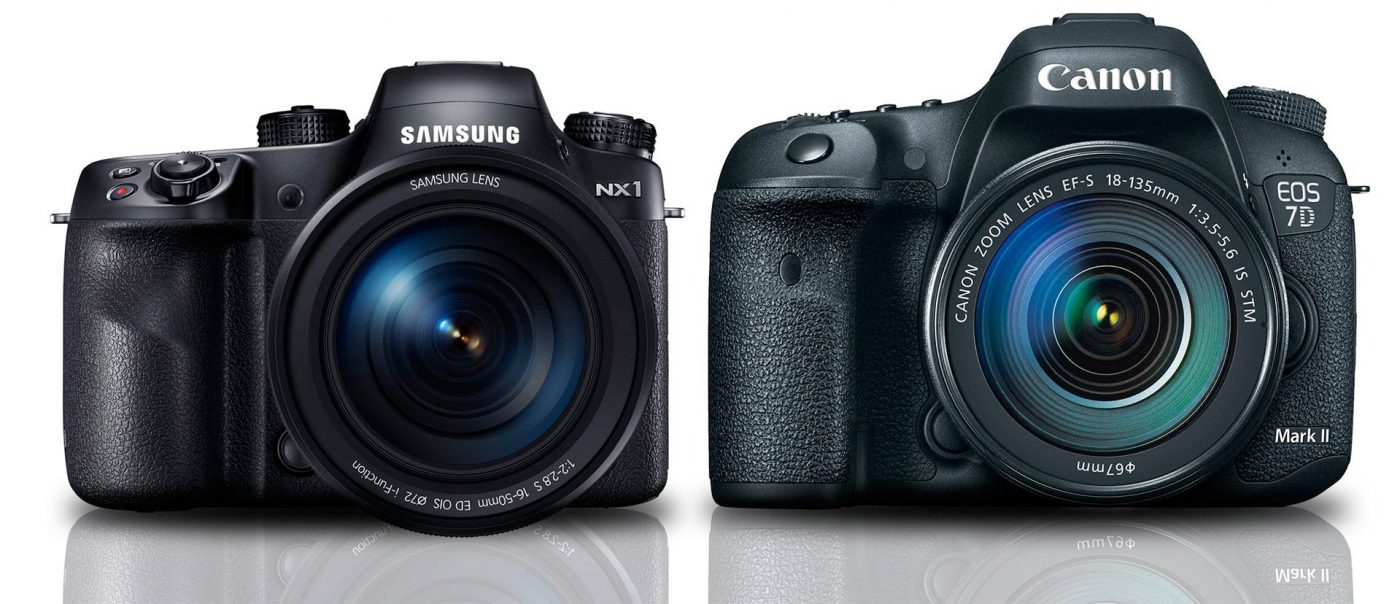Samsung NX1 vs Canon 7D Mark II
Mirrorless cameras have come of age this year, and some of the most exciting new cameras have been delivered by consumer electronics giants rather than traditional camera companies. Sony has been making in-roads into professional photography for years, but the recent A7 line has solidified their standing among the best. Samsung is now joining the front-runners with the metal-bodied, weather-sealed NX1, perhaps the most feature-rich camera to be announced this year, and they’ve bolstered it’s chances of success with professionals by adding an impressive pair of stabilized, weather-sealed lenses: a 16-50mm f/2.0-2.8 and 50-150mm f/2.8 that cover the common 24-70 and 70-200 ranges used by photojournalists. As the NX1 is an APS-C camera, it may be instructive to take a look at how it compares to Canon’s equally new 7D Mark II, which started shipping about two weeks ago. The Canon 7D II is intended to be a professional or semi-professional body; it’s Canon’s current top-of-the-line APS-C, and as such, a good benchmark for comparison.
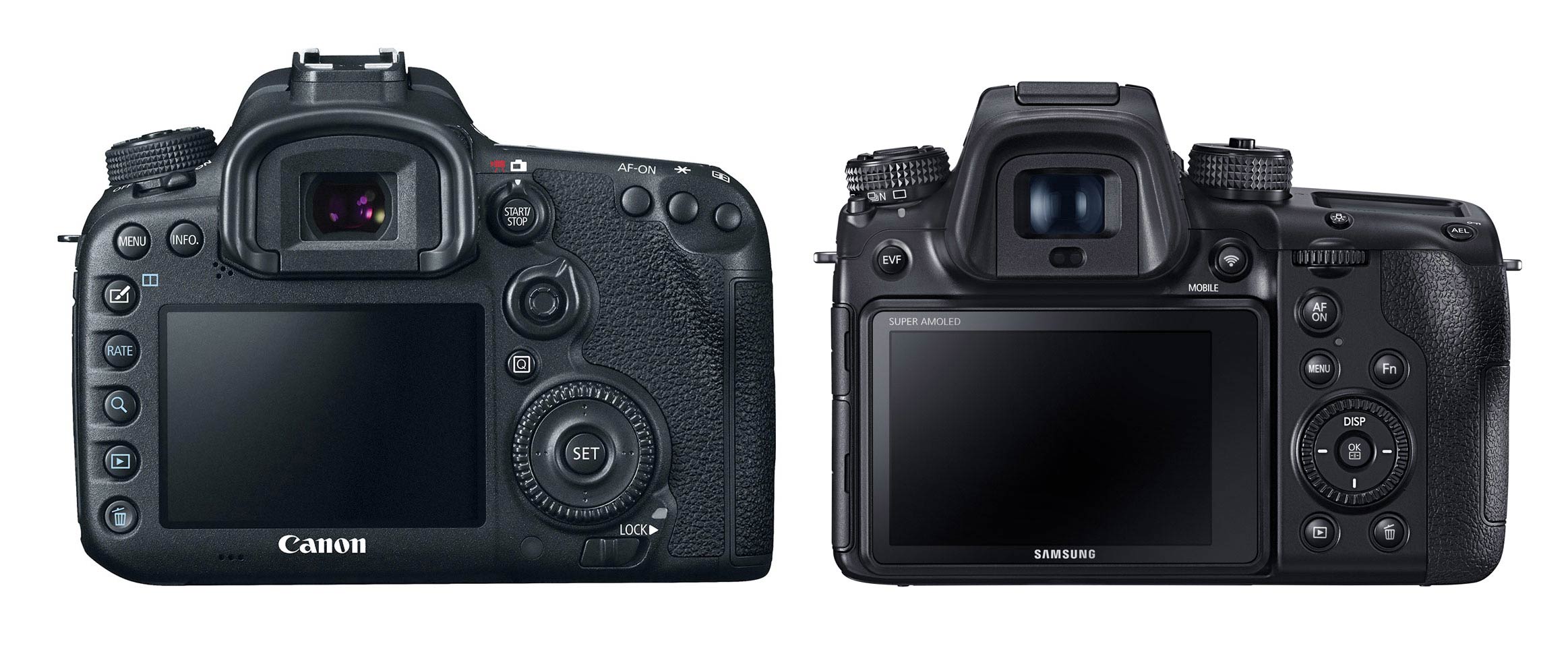
Comparison Overview
The numbers don’t tell the whole story, but they’re an important place to start. Instances in which the Samsung appears to be superior are highlighted in green.
| Canon 7D Mark II | Samsung NX1 | |
|---|---|---|
| Price | $1,389.95 ($1799 at release) | $ ($1499 at release) |
| Sensor Size | APS-C (1.6x Crop) | APS-C (1.5x Crop) |
| Sensor Resolution | 20.2 Megapixel | 28 Megapixel |
| ISO Range | 100-16000 | 100-25600 |
| shutter speeds | 30-1/8000 | 30-1/8000 |
| flash sync | 1/250th | 1/250th |
| Max. Frame Rate | 10 fps 14-bit | 15 fps12-bit |
| Max. RAW Burst | 31 14-bit | 25 12-bit (with UHS-I card, UHS-II Cards supported) |
| Max. JPG Burst | 1090 | 139 (with UHS-I card, UHS-II Cards supported) |
| Autofocus Points (total) | 65 | 205 |
| Autofocus Points (cross-type) | 65 | 153 |
| AF Coverage (% of frame) | Approx. 40% | 90% |
| AF Sensitivity | -3 EV (center) | -2 EV (Phase Detect) -4 EV (Contrast Detect) |
| Full Autofocus For Video | Yes | Yes |
| Video Resolutions | 1080p @ 24, 30, 60 fps 720p @ 24, 30, 60 fps | DCI 4K @ 24 fps UHD @ 30 fps 1080 @ 24, 30, 60 fps 720 @ 60, 30 fps |
| Video Codec | h264 | h265 |
| Video Out | Uncompressed 1080p HDMI | Uncompressed 8-bit 4:2:0 4K Video, HDMI or Uncompressed 1080p |
| Card Slots | 1 Compact Flash 1 SD / SDHC / SDXC | 1 SD / SDHC / SDXC |
| Connectivity | USB 3.0 | Wi-Fi (802.11ac) Bluetooth NFC USB 3.0 |
| GPS | Built In | Only If Synced With Phone |
| Battery Life | 670 shots | 500 shots |
| Body Material | Magnesium Alloy | Magnesium Alloy |
| Weight (body only) | 820g / 1.8 lb. | 550g / 1.21lb. |
| Viewfinder Type | Optical | Electronic (2.36 million px AMOLED) |
| 100% Coverage 1x Magnification | 100% Coverage 1.04x Magnification |
As you can see, the Samsung NX1 dominates the spec table. This is hardly surprising, as the Canon is hampered by the constraints of working around a flapping-mirror box, while the Samsung has sidestepped these limitations by spurning the optical viewfinder in favor of an electronic one (EVF). Consequently, the Canon has to deal with focusing, flipping up the mirror, releasing the shutter, returning the mirror to its down-position, and dampening the vibrations entailed by that movement all in 1/10th of a second to fire at 10 fps, while the Samsung simply has to release its shutter repeatedly and move the data through the processing pipeline, making it much easier to achieve it’s top speed of 15 frames per second.
The Sensors
But this isn’t just a matter of SLR vs mirrorless. Samsung’s unique sensor also plays a significant role in the NX1’s impressive performance.
The Samsung NX1’s 28 megapixel sensor is the highest resolution APS-C sensor available, and like Nikon’s 24 megapixel sensors in the D5300/7100, the NX1’s sensor does not employ an optical low-pass filter1 An optical low pass blurs the image at the pixel level. Historically, this was used to reduce a pixelated, jagged look to sharp edges and details, but with the miniscule size of modern photosensors and improved processing capabilities, they’re falling out of favor , so the input is as sharp as possible. Just as importantly, it is a type of sensor never seen in an application of this size before: a back-side illumination (BSI) CMOS sensor. In a BSI-CMOS sensor, the light sensitive layer of the sensor has been flipped over so that the wiring for the photo diodes (the light sensitive photo sites) is behind the surface that gathers light. In traditional sensors the wiring layer can block a substantial amount of light, so the Samsung’s BSI CMOS may receive 60-80% more light than a FSI CMOS.
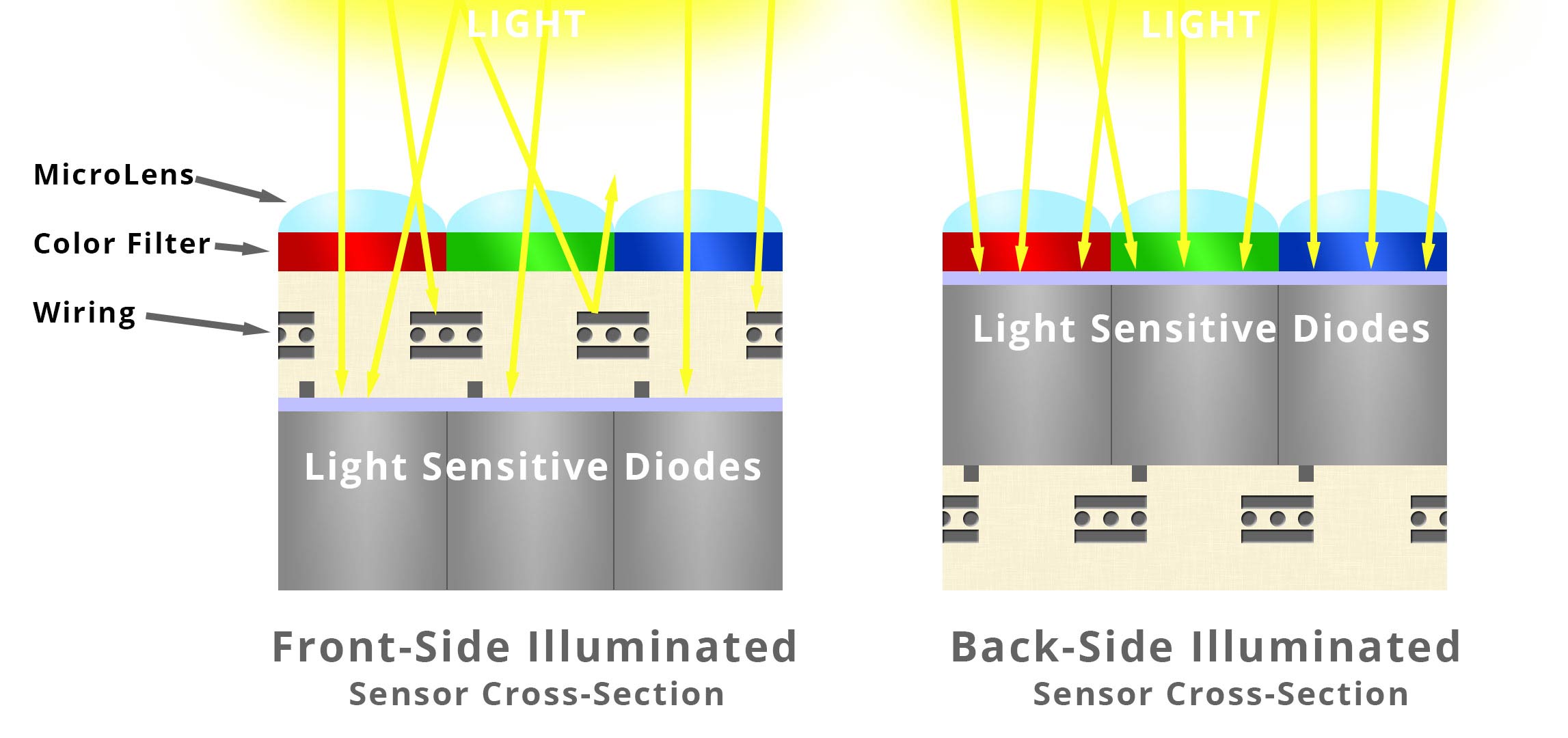
Consequently, the Samsung’s sensor has the potential for lower noise at high ISO. This is reflected in the NX1’s higher top native ISO, but the practical difference remains to be seen in a production model.
The 7D Mark II’s sensor is also pretty impressive, though. For those times when the mirror is locked up (for live-view or video) and the standard phase-detection AF system is offline, the Canon sensor features integrated phase-detection pixels that give it the best live-view autofocus system of any DSLR; the AF system is even suitable for professional video work, unlike any Nikon camera, for example. Because the Samsung NX1 is a mirrorless, it can always use the same AF system whether it’s shooting video or stills.
Speed
The numbers here are pretty clear: the Samsung shoots an unprecedented 15 frames per second, a rate that has never been seen in the APS-C DSLR market. The Canon 7D II shoots at 10 frames per second, though, which makes it the best of the DSLRs (the Samsung is a mirrorless, thus not truly an SLR). It’s worth mentioning that the Samsung drops from 14-bit to 12-bit RAW files when shooting continuously, while the Canon retains full bit-depth. Furthermore, the Canon can shoot longer bursts, as tested: about 31 RAW files compared to the NX1’s 25. However, the numbers provided by Samsung rely on a UHS-I SD card, while the camera supports much faster UHS-II cards, which may help the Samsung close the gap.
Video
The Samsung NX1 is the first APS-C camera to offer 4K video capture2 4K video is roughly 4000 pixels wide with a total resolution about 4 times higher than full 1080p HD video. (though Sony’s A7s and Panasonic’s GH4 can shoot 4K at full-frame and Micro 4/3rds, respectively), and also the first camera to use the new H265 codec which promises to produce files of equivalent quality at about half the size of the H264 codec. It can also deliver uncompressed 4:2:0 4K video through the HDMI jack if you’d like to use an external recorder without losing data to compression. Like the Canon 70D, the NX1’s touchscreen allows you to select points to pull focus by touch while shooting.
The Canon simply can’t produce 4K video, but it does offer high quality 1080p capture and uncompressed HDMI output. Because the 7D does NOT have a touch screen, it is not capable of some of the automatic focus-pull features that the Canon 70D has, but it does have customizable AF speed if you’d like to speed-up or slow-down a focus transition while filming.
Both cameras can autofocus quickly and accurately while shooting video, unlike most SLRs3 The Canon 70D being the only exception, along with Sony’s SLTs and other mirrorless cameras , and both systems offer lenses with stepping motors to improve smooth focusing and accuracy while shooting video. Both have microphone and headphone jacks.
Autofocus
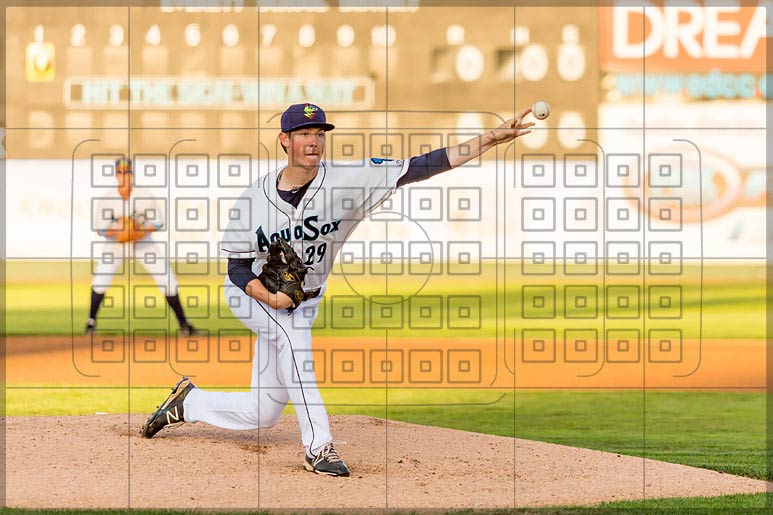
The Canon 7D Mark II has the fastest, most sophisticated AF system of any APS-C DSLR. It has four times more cross-type AF points than the Nikon D7100 (15), and can track subjects by using their color data along with their distance from the camera… all technology lifted from the EOS 1DX, arguably the best camera for action photography, period. This is a tried and true system, perfect for the most demanding action photography.
That said, the Samsung NX1 claims to have the fastest autofocus performance in the world. We’ve seen the same claim from Fujifilm4In 2012, with the XT-1. and Olympus5With the OM-D E-M5 cameras in the past, though, and while it may be true when focusing on stationary objects, their tracking performance has been less reliable than entry level SLRs in real world use. The NX1 is sophisticated enough that it may have made leaps in AF performance, but this remains to be thoroughly tested.
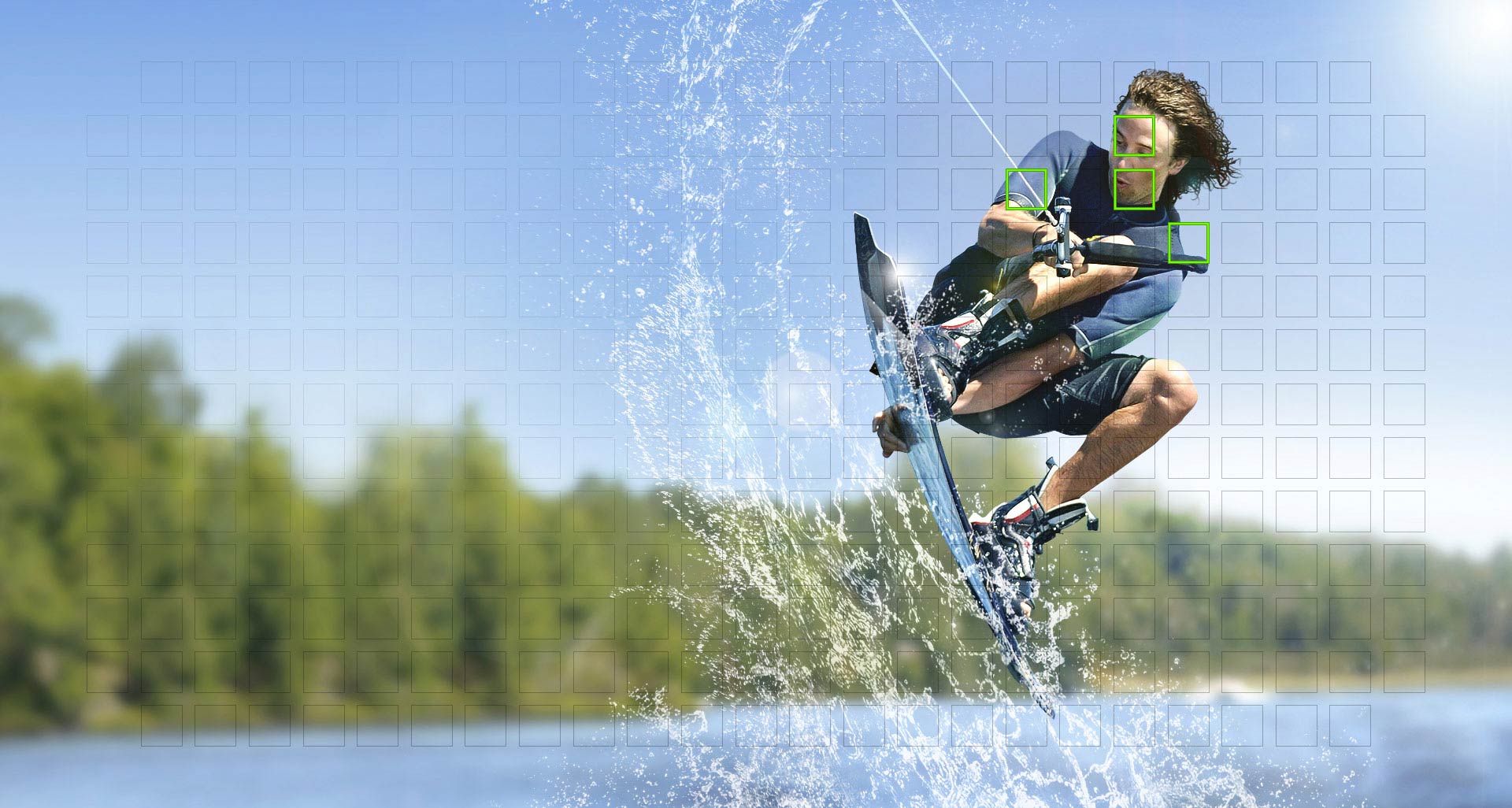
Where the Samsung has the clear advantage, though, is in AF coverage of the frame. The NX1’s 205 autofocus points cover almost the entire frame, leaving just a tiny gap at the borders and in the corners, so no matter where your subject is in the frame, you’ll be able to focus on it. The 7D II, like most SLRs, has all of its AF points crowded into the center 40% of the frame.
The Bells & Whistles
When it comes to all of the “extras” that people have begun to expect, the Samsung NX1 is loaded. It has built-in Wi-Fi, bluetooth, NFC, and if you sync it with your phone (which is possible via bluetooth and wi-fi), you can pull in GPS data or take remote control of the camera. Rear LCD touch-screen is articulated for use when shooting with the camera above or below eye level, and the body is weather sealed like the 7D Mark II.
If you don’t feel like doing all the work, the Samsung NX1 can be set to take pictures of peak action automatically using a remarkable predictive shutter release system that currently has two modes: baseball, and jump. In baseball mode, the camera will track the batter and ball in in the frame and release the shutter when the ball and bat connect. Similarly, the “jump” mode will release the shutter when the subject has reached the peak of their jump. Pretty amazing, if it works as advertised.
The Canon 7D Mark II has built-in GPS, but otherwise has only standard connectivity: USB 3.0. It is also the first Canon to have a built-in intervalometer and bulb-timer. The Canon’s rear LCD screen is neither articulated nor touch-screen.
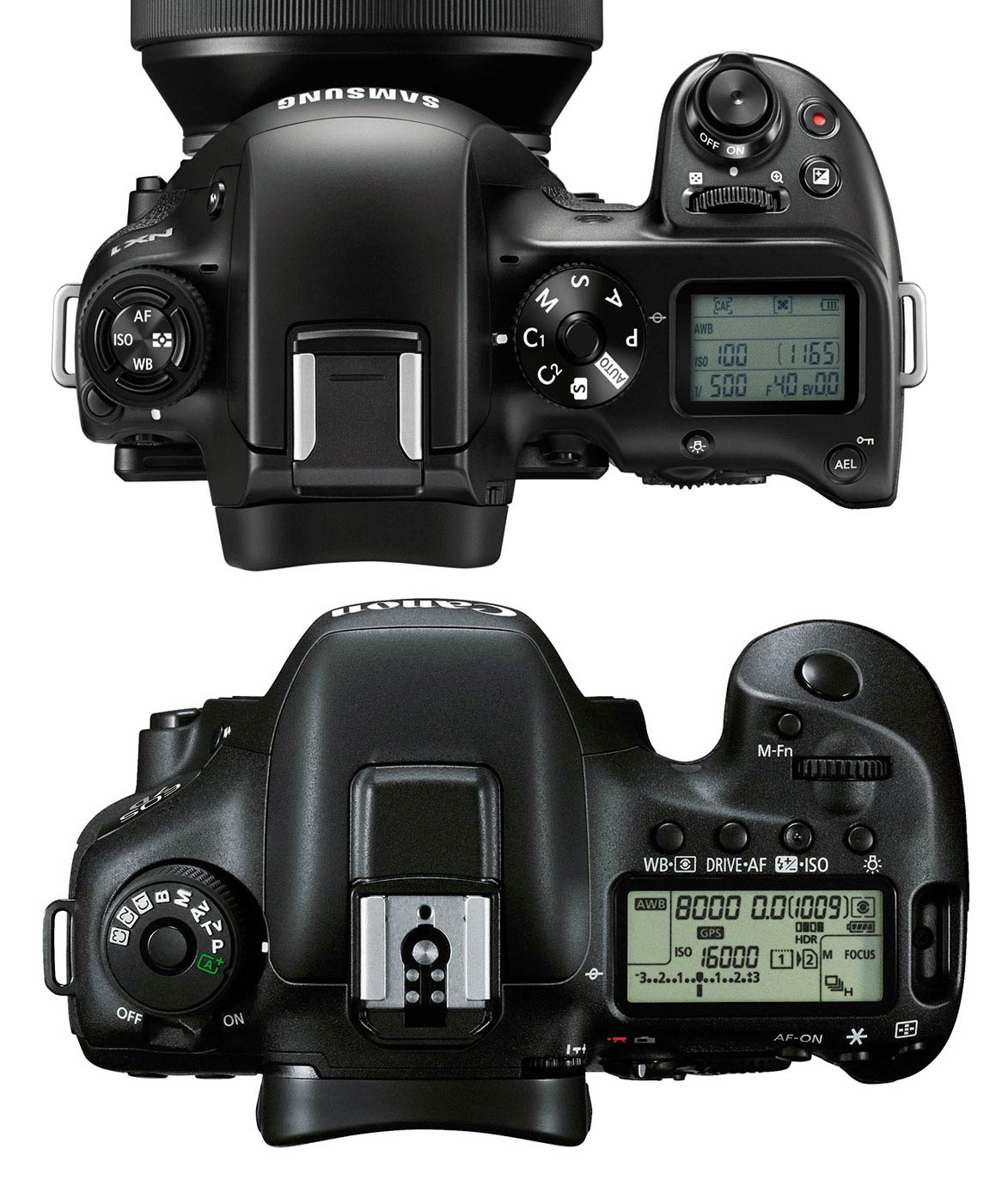
The Samsung NX1’s Drawbacks
The NX1 has professional level performance, build, and features at a reasonable price, but don’t expect everyone to jump onto the Samsung bandwagon just yet. While a camera body is an important piece of equipment, a working photographer needs an entire system of lenses, flashes, and other peripherals.
Currently, the NX1 has a several very nice lenses that are suited to the working professional: a stabilized 16-50 f/2-2.8 and 50-150 f/2.8, which cover the range of the traditional 24-70 and 70-200 workhorses, and there’s been recent news of a 300mm f/2.8 supertelephoto that’s in the works. A 60mm f/2.8 Macro lens is available, along with 85mm f/1.4 and 45mm f/1.8 primes and a few pancake primes.
However, there are currently no telephoto lenses beyond the 200mm focal length. Samsung makes a 12-24mm f/4-5.6, but there are no large aperture lenses that are wider than the 16-50mm f/2 zoom. And unfortunately, other lens manufacturers are not yet offering Samsung mounts for most of their lenses, so if you’d like to use a Sigma 18-35 f/1.8 or 35mm or 50mm f/1.4 “Art”, you’ll have to wait and hope… and the same is true of Tamron’s popular 70-200 f/2.8 or Tokina’s excellent 11-16 f/2.8.
And when it comes to flash equipment, the Samsung system has a paucity of options. The Samsung ED-SEF580A is a decent shoe-mount flash, but it’s pricey and has no pc or 1/8th” jacks or optical slave. There are no pocket-wizards designed for the Samsung, and finding similar triggers from other brands will be difficult, if they exist at all. You may be able to use “dumb” triggers along with manual flash equipment, but even that can be a little limiting in this day and age.
So, Should You Buy the Samsung NX1?
The answer depends on how you feel about being an early-adopter. Samsung seems committed to producing a professional quality camera system, but until it gains widespread use, you’ll run into some serious limitations. If you’re looking for a large sensor camera that can shoot 4K video, the Samsung NX1 is a great option (and much less expensive than the Sony A7s) but it shoots video in a new format that has minimal support. If the H265 codec doesn’t begin replacing the H264, you may find yourself with a bunch of videos to store next to your 8-track tapes (although they can be converted into other formats, if necessary). YouTube does not support H265 yet.
If you’re not a professional or you shoot in such a way that you don’t mind working around these limitations, the NX1 is a top-notch camera, outperforming even Canon’s best APS-C model in many ways. This is one of the few cameras not made by Nikon or Canon that I’d consider to replace my own gear, though the full-frame Sony A7 and Fujifilm cameras are strong contenders.
Questions? Opinions?
Please let us know in the comment section below!

